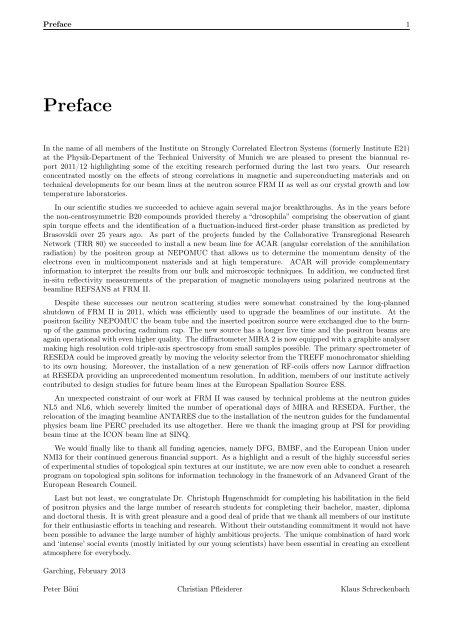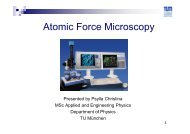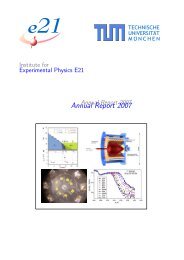Annual Report 2011 / 2012 - E21 - Technische Universität München
Annual Report 2011 / 2012 - E21 - Technische Universität München
Annual Report 2011 / 2012 - E21 - Technische Universität München
You also want an ePaper? Increase the reach of your titles
YUMPU automatically turns print PDFs into web optimized ePapers that Google loves.
Preface 1<br />
Preface<br />
In the name of all members of the Institute on Strongly Correlated Electron Systems (formerly Institute <strong>E21</strong>)<br />
at the Physik-Department of the Technical University of Munich we are pleased to present the biannual report<br />
<strong>2011</strong>/12 highlighting some of the exciting research performed during the last two years. Our research<br />
concentrated mostly on the effects of strong correlations in magnetic and superconducting materials and on<br />
technical developments for our beam lines at the neutron source FRM II as well as our crystal growth and low<br />
temperature laboratories.<br />
In our scientific studies we succeeded to achieve again several major breakthroughs. As in the years before<br />
the non-centrosymmetric B20 compounds provided thereby a “drosophila” comprising the observation of giant<br />
spin torque effects and the identification of a fluctuation-induced first-order phase transition as predicted by<br />
Brasovskii over 25 years ago. As part of the projects funded by the Collaborative Transregional Research<br />
Network (TRR 80) we succeeded to install a new beam line for ACAR (angular correlation of the annihilation<br />
radiation) by the positron group at NEPOMUC that allows us to determine the momentum density of the<br />
electrons even in multicomponent materials and at high temperature. ACAR will provide complementary<br />
information to interpret the results from our bulk and microscopic techniques. In addition, we conducted first<br />
in-situ reflectivity measurements of the preparation of magnetic monolayers using polarized neutrons at the<br />
beamline REFSANS at FRM II.<br />
Despite these successes our neutron scattering studies were somewhat constrained by the long-planned<br />
shutdown of FRM II in <strong>2011</strong>, which was efficiently used to upgrade the beamlines of our institute. At the<br />
positron facility NEPOMUC the beam tube and the inserted positron source were exchanged due to the burnup<br />
of the gamma producing cadmium cap. The new source has a longer live time and the positron beams are<br />
again operational with even higher quality. The diffractometer MIRA 2 is now equipped with a graphite analyser<br />
making high resolution cold triple-axis spectroscopy from small samples possible. The primary spectrometer of<br />
RESEDA could be improved greatly by moving the velocity selector from the TREFF monochromator shielding<br />
to its own housing. Moreover, the installation of a new generation of RF-coils offers now Larmor diffraction<br />
at RESEDA providing an unprecedented momentum resolution. In addition, members of our institute actively<br />
contributed to design studies for future beam lines at the European Spallation Source ESS.<br />
An unexpected constraint of our work at FRM II was caused by technical problems at the neutron guides<br />
NL5 and NL6, which severely limited the number of operational days of MIRA and RESEDA. Further, the<br />
relocation of the imaging beamline ANTARES due to the installation of the neutron guides for the fundamental<br />
physics beam line PERC precluded its use altogether. Here we thank the imaging group at PSI for providing<br />
beam time at the ICON beam line at SINQ.<br />
We would finally like to thank all funding agencies, namely DFG, BMBF, and the European Union under<br />
NMI3 for their continued generous financial support. As a highlight and a result of the highly successful series<br />
of experimental studies of topological spin textures at our institute, we are now even able to conduct a research<br />
program on topological spin solitons for information technology in the framework of an Advanced Grant of the<br />
European Research Council.<br />
Last but not least, we congratulate Dr. Christoph Hugenschmidt for completing his habilitation in the field<br />
of positron physics and the large number of research students for completing their bachelor, master, diploma<br />
and doctoral thesis. It is with great pleasure and a good deal of pride that we thank all members of our institute<br />
for their enthusiastic efforts in teaching and research. Without their outstanding commitment it would not have<br />
been possible to advance the large number of highly ambitious projects. The unique combination of hard work<br />
and ‘intense’ social events (mostly initiated by our young scientists) have been essential in creating an excellent<br />
atmosphere for everybody.<br />
Garching, February 2013<br />
Peter Böni Christian Pfleiderer Klaus Schreckenbach




